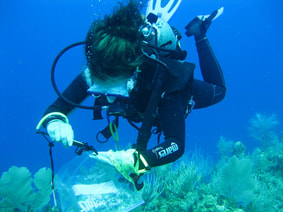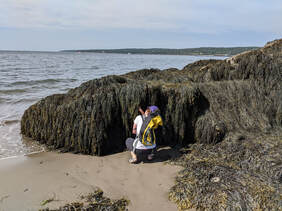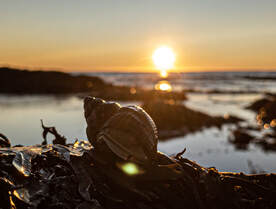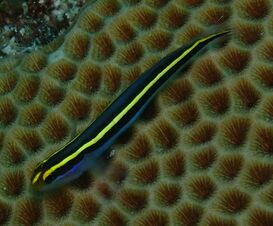Research in the D’Aloia Lab lies at the intersection of marine ecology, evolution, and conservation biology. Questions of interest include:
- How does dispersal interact with demographic and environmental stochasticity to affect the spatio-temporal structure of alleles, individuals, and populations?
- Do close kin interact in marine populations with a dispersive phase?
- How might connectivity patterns change, given the growing human footprint on the ocean?
- What is the fate of microhabitat specialist, dispersal limited species occupying rapidly changing seascapes?

Larval dispersal
Much of our research centers around the ecological process of larval dispersal, wherein individuals move from their birth site to a breeding site. For marine species with limited adult mobility, the larval phase offers an opportunity for individuals to reach new habitat. But research has shown that some individuals stay very close to home, while others travel vast distances. We are interested in measuring this variability in dispersal capacity and understanding why it exists. We primarily use genetic approaches such as parentage analysis and population assignment tests to figure out how far larvae travel. We also explore how movement during early life stages impacts gene flow and population dynamics. In recent years, have also begun to explore dispersal in direct-developing species.
Much of our research centers around the ecological process of larval dispersal, wherein individuals move from their birth site to a breeding site. For marine species with limited adult mobility, the larval phase offers an opportunity for individuals to reach new habitat. But research has shown that some individuals stay very close to home, while others travel vast distances. We are interested in measuring this variability in dispersal capacity and understanding why it exists. We primarily use genetic approaches such as parentage analysis and population assignment tests to figure out how far larvae travel. We also explore how movement during early life stages impacts gene flow and population dynamics. In recent years, have also begun to explore dispersal in direct-developing species.

Seascape genomics
The field of seascape genomics is generating new insights into how demographic processes, selection, and seascape features shape the spatio-temporal distribution of genetic variation within marine metapopulations. We are especially interested in understanding how species' intrinsic dispersal abilities interact with extrinsic seascape drivers to influence realized connectivity.
The field of seascape genomics is generating new insights into how demographic processes, selection, and seascape features shape the spatio-temporal distribution of genetic variation within marine metapopulations. We are especially interested in understanding how species' intrinsic dispersal abilities interact with extrinsic seascape drivers to influence realized connectivity.

Genomics for conservation and management
We are broadly interested in the role that genetic and genomic data can play in conservation planning. We have conceptual and empirical projects that explore both the value and the limitations of these data. In terms of conceptual projects, we are interested in exploring how data on connectivity and adaptive potential can be effectively integrated into spatial conservation plans. For empirical work, in Atlantic Canada, we are partnering with government and industry on new projects exploring stock structure and connectivity in commercially harvested species (cod and whelk), in an effort to support sustainable management.
We are broadly interested in the role that genetic and genomic data can play in conservation planning. We have conceptual and empirical projects that explore both the value and the limitations of these data. In terms of conceptual projects, we are interested in exploring how data on connectivity and adaptive potential can be effectively integrated into spatial conservation plans. For empirical work, in Atlantic Canada, we are partnering with government and industry on new projects exploring stock structure and connectivity in commercially harvested species (cod and whelk), in an effort to support sustainable management.

Kin structure
The distribution of close kin (e.g., parent-offspring pairs, full sibs, or half-sibs) within populations can impact kin competition, inbreeding, and kin selection. To date, evidence for within-population kin aggregations has been mixed for species with a dispersive larval phase. We are combining genetic and mathematical approaches to understand how kin groups could form within marine populations. Recent projects have explored the effects of stochastic demographic processes, collective larval movement, and limited dispersal on spatial patterns of kinship. We are currently studying whether small, group-living coral reef fishes form kin groups.
The distribution of close kin (e.g., parent-offspring pairs, full sibs, or half-sibs) within populations can impact kin competition, inbreeding, and kin selection. To date, evidence for within-population kin aggregations has been mixed for species with a dispersive larval phase. We are combining genetic and mathematical approaches to understand how kin groups could form within marine populations. Recent projects have explored the effects of stochastic demographic processes, collective larval movement, and limited dispersal on spatial patterns of kinship. We are currently studying whether small, group-living coral reef fishes form kin groups.
Our research is currently supported by the Natural Sciences and Engineering Research Council of Canada, Fisheries & Oceans Canada, the Connaught Fund, and the University of Toronto.